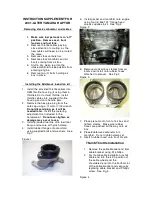
-
27
-
Emergency Response (Continued)
Spills
The RX 450h contains the same common automotive fluids used in other non-
hybrid Lexus vehicles, with the exception of the NiMH electrolyte used in the
HV battery pack. The NiMH battery electrolyte is a caustic alkaline (pH
13.5) that is damaging to human tissues. The electrolyte, however, is
absorbed in the cell plates and will not normally spill or leak out even if a
battery module is cracked. A catastrophic crash that would breach both the
metal battery pack case and a battery module would be a rare occurrence.
Similar to the use of baking soda to neutralize a lead-acid battery electrolyte
spill, a dilute boric acid solution or vinegar can be used to neutralize a NiMH
battery electrolyte spill.
NOTE:
Electrolyte leakage from the HV battery pack is unlikely due to its
construction and the amount of available electrolyte contained within the
NiMH modules. Any spillage would not warrant a declaration as a hazardous
material incident. Responders should follow the recommendations as outlined
in this emergency response guide.
In an emergency, manufacturer’s Material Safety Data Sheets (MSDS) are
available by contacting:
United States: CHEMTREC at (800) 424-9300
Canada: CANUTEC at *666 or (613) 996-6666 (collect)
•
Handle NiMH electrolyte spills using the following Personal Protective
Equipment (PPE):
Splash shield or safety goggles. Fold down helmet shields are not
acceptable for acid or electrolyte spills.
Rubber, latex or nitrile gloves.
Apron suitable for alkaline.
Rubber boots.
•
Neutralize NiMH Electrolyte
Use a boric acid solution or vinegar.
Boric acid solution - 800 grams boric acid to 20 liters water or 5.5
ounces boric acid to 1 gallon of water.
First Aid
Emergency responders may not be familiar with a NiMH electrolyte exposure
when rendering aid to a patient. Exposure to the electrolyte is unlikely except
in a catastrophic crash or through improper handling. Utilize the following
guidelines in the event of exposure.
WARNING:
The NiMH battery electrolyte is a caustic alkaline (pH 13.5) that is
damaging to human tissues. To avoid injury by coming in contact with
the electrolyte, wear proper personal protective equipment.
•
Wear Personal Protective Equipment (PPE)
Splash shield or safety goggles. Fold down helmet shields are not
acceptable for acid or electrolyte spills.
Rubber, latex or nitrile gloves.
Apron suitable for alkaline.
Rubber boots.
•
Absorption
Perform gross decontamination by removing affected clothing and
properly disposing of the garments.
Rinse the affected areas with water for 20 minutes.
Transport patients to the nearest emergency medical care facility.
•
Inhalation in Non-Fire Situations
No toxic gases are emitted under normal conditions.
•
Inhalation in Fire Situations
Toxic gases are given off as by-products of combustion. All
responders in the Hot Zone should wear the proper PPE for fire
fighting including SCBA.
Move a patient from the hazardous environment to a safe area and
administer oxygen.
Transport patients to the nearest emergency medical care facility.
•
Ingestion
Do not induce vomiting.
Allow the patient to drink large quantities of water to dilute the
electrolyte (never give water to an unconscious person).






































